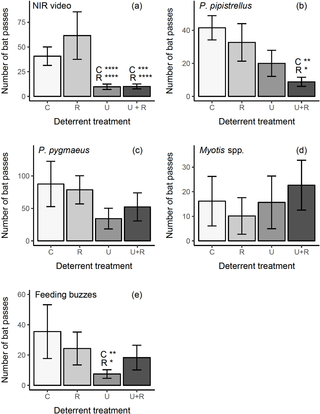Ultrasonic deterrents have limited effects on reducing bat fatalities at wind facilities
New research suggests limited effectiveness of ultrasonic deterrents for bats at wind facilities

Bats frequently collide with spinning wind turbine blades, especially during the fall migratory period, where hundreds of thousands of bats are estimated to occur at wind facilities annually. The two main strategies to reduce bat fatalities at wind farms are curtailment (stopping turbines during high-risk periods) and deterrents (discouraging bat activity around turbines). Research from this study by Clerc and colleagues suggests that ultrasonic deterrents had little effect on bats as a whole and may have actually increased mortality in eastern red bats. Due to the inconsistent results among species groups, researchers advise caution when using ultrasonic deterrents to reduce bat mortality, particularly in species for which the effects have not been studied.
Importance of reducing bat fatalities at wind facilities
Bat fatalities at wind facilities have the potential to impact populations, such as hoary bats, that are particularly susceptible to collisions. The most popular curtailment approach is to stop turbine operation during low wind speeds, when bat activity is typically higher. Stopping blades minimizes the likelihood of a bat collision. The most studied deterrents involve ultrasonic noises emitted from the wind turbine to deter bats from flying in proximity to the blades.
In past studies, curtailment has been shown to be effective in reducing bat fatalities by an average of 62% when turbines are not spinning at wind speeds of 5 m/s or less; thus, wind-only curtailment is currently the most widely accepted approach to curtailment. Despite the success of curtailment in reducing bat fatalities, there is a loss of energy generation; thus, there is interest in developing deterrents that reduce bat fatalities while minimizing or eliminating energy production loss. Furthermore, using curtailment and deterrents together may provide additional fatality reduction compared to using either method alone.
How was the study done?
Researchers Clerc and colleagues set out to study the effectiveness of curtailment and deterrents by comparing the number of fatalities found under turbines that used no treatment, curtailment alone, ultrasonic deterrents alone, or a combination of the two. During the study period, each of the four treatments was randomly assigned nightly to 4 of the 16 total turbines used for the study. The researchers searched for carcasses underneath all 16 turbines every morning during the study period and used models to understand the effectiveness of curtailment and deterrents on bat mortality.
What did the study find?
The study showed mixed results for the effectiveness of deterrents on bat mortality. When researchers examined all bat species combined and low-frequency calling species (hoary bats, silver-haired bats, and big brown bats), there was some evidence that ultrasonic deterrents reduced mortality; however, the relationship was equivocal and not as strong as expected. Conversely, researchers were surprised that ultrasonic deterrents increased eastern red bat mortality by a factor of two compared to when the ultrasonic deterrents were not active.
What do the results mean?
With a lack of definitive evidence regarding the effectiveness of ultrasonic deterrents, this approach is unlikely to be more effective than curtailment for either of the species groups examined in this study, especially for eastern red bats. Previous studies have found that ultrasonic deterrents have been effective in natural settings; however, the same results were not observed in this study at a wind facility. Researchers speculate that these differences may be due to the deterrents not fully covering the large wind turbines or because bat behavior differs around wind turbines compared to other habitats.
Regardless of the mechanism behind the differences in responses to ultrasonic deterrents among bat species groups, the researchers suggest caution with their use, especially with species where the effects have not been studied. This caution is especially heightened given the significant increase in eastern red bat fatalities that occurred when ultrasonic detectors were used.
References
Clerc, J., M. Huso, M. Schirmacher, M. Whitby, and C. Hein. 2025. Ultrasonic deterrents provide no additional benefit over curtailment in reducing bat fatalities at an Ohio wind energy facility. PLOS ONE 20:e0318451.

Friedenberg, N. A., and W. F. Frick. 2021. Assessing fatality minimization for hoary bats amid continued wind energy development. Biological Conservation 262:109309. https://www.sciencedirect.com/science/article/abs/pii/S000632072100361X?via%3Dihub
Gilmour, L. R. V., M. W. Holderied, S. P. C. Pickering, G. Jones. 2020. Comparing acoustic and radar deterrence methods as mitigation measures to reduce human-bat impacts and conservation conflicts. PLoS One. 2020;15(2):e0228668. https://doi.org/10.1371/journal.pone.0228668 PMID: 32053663








